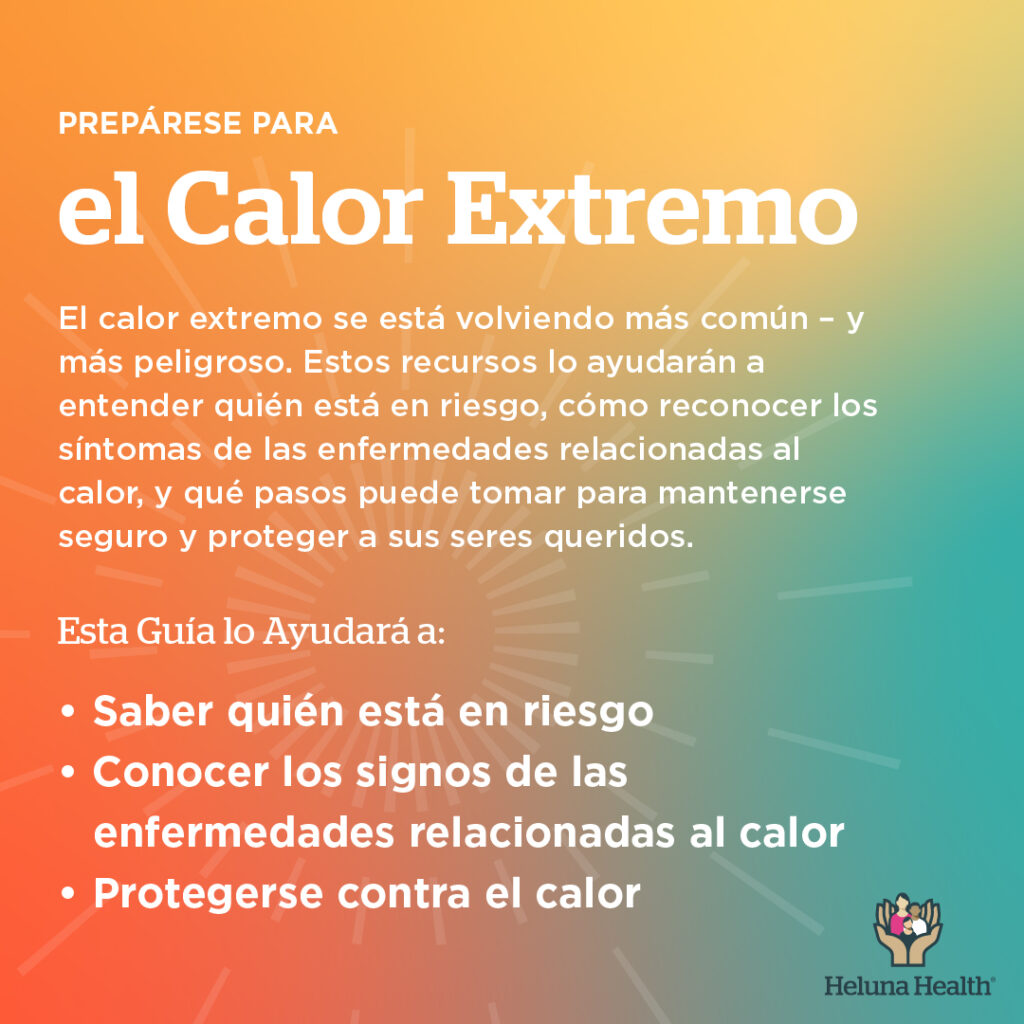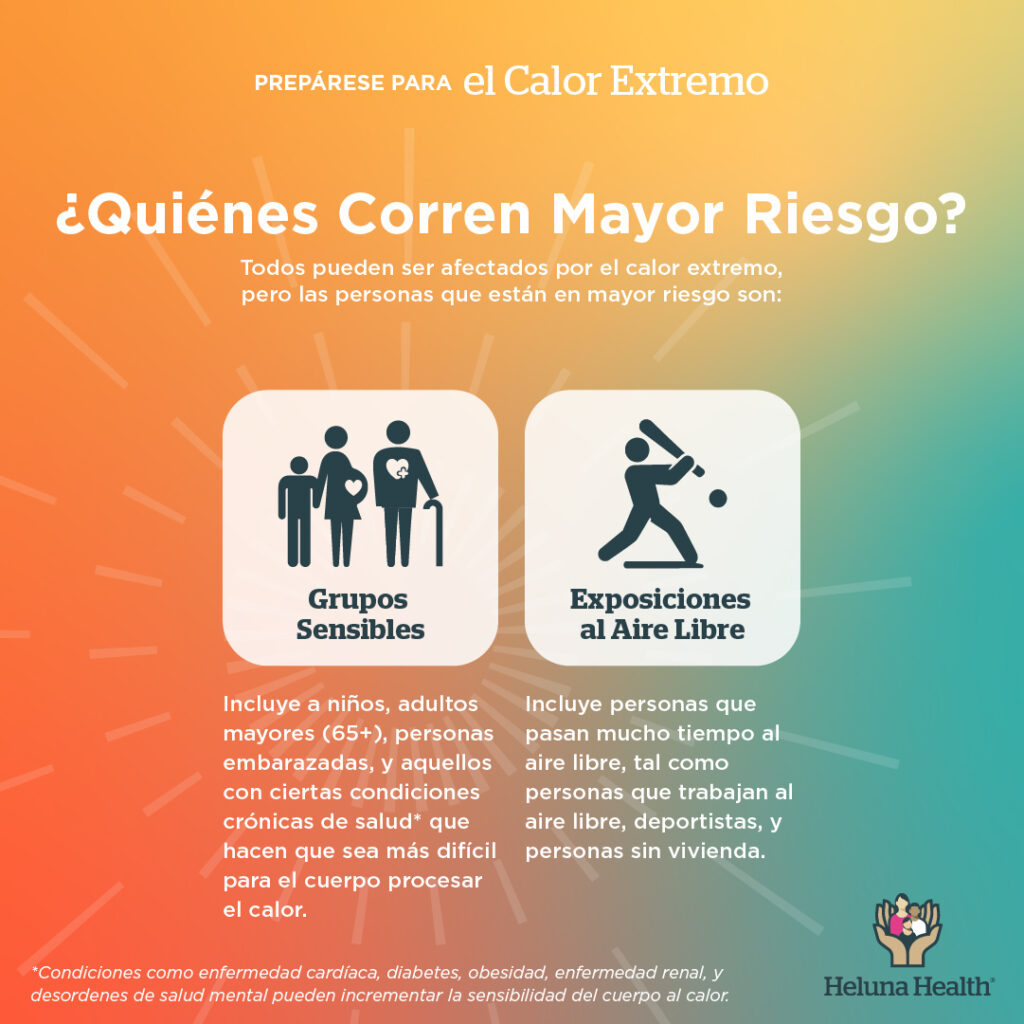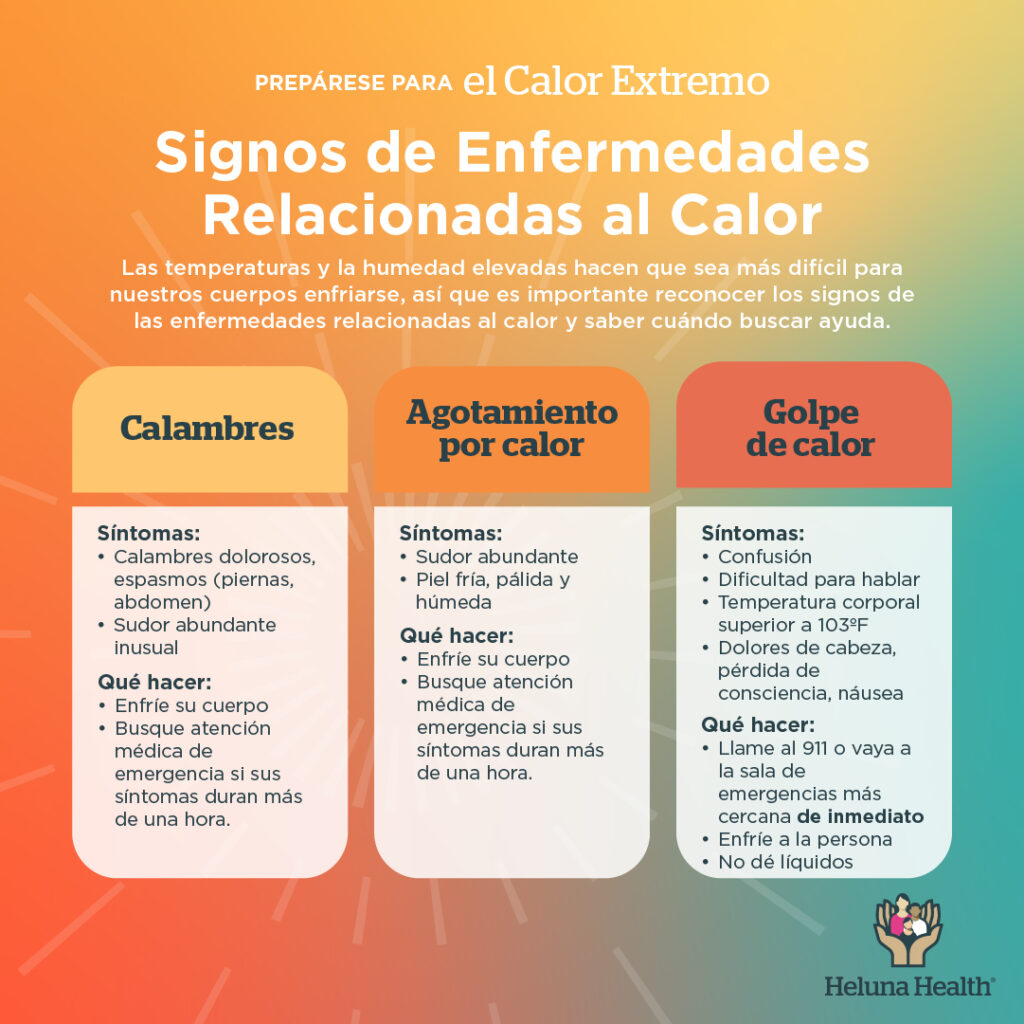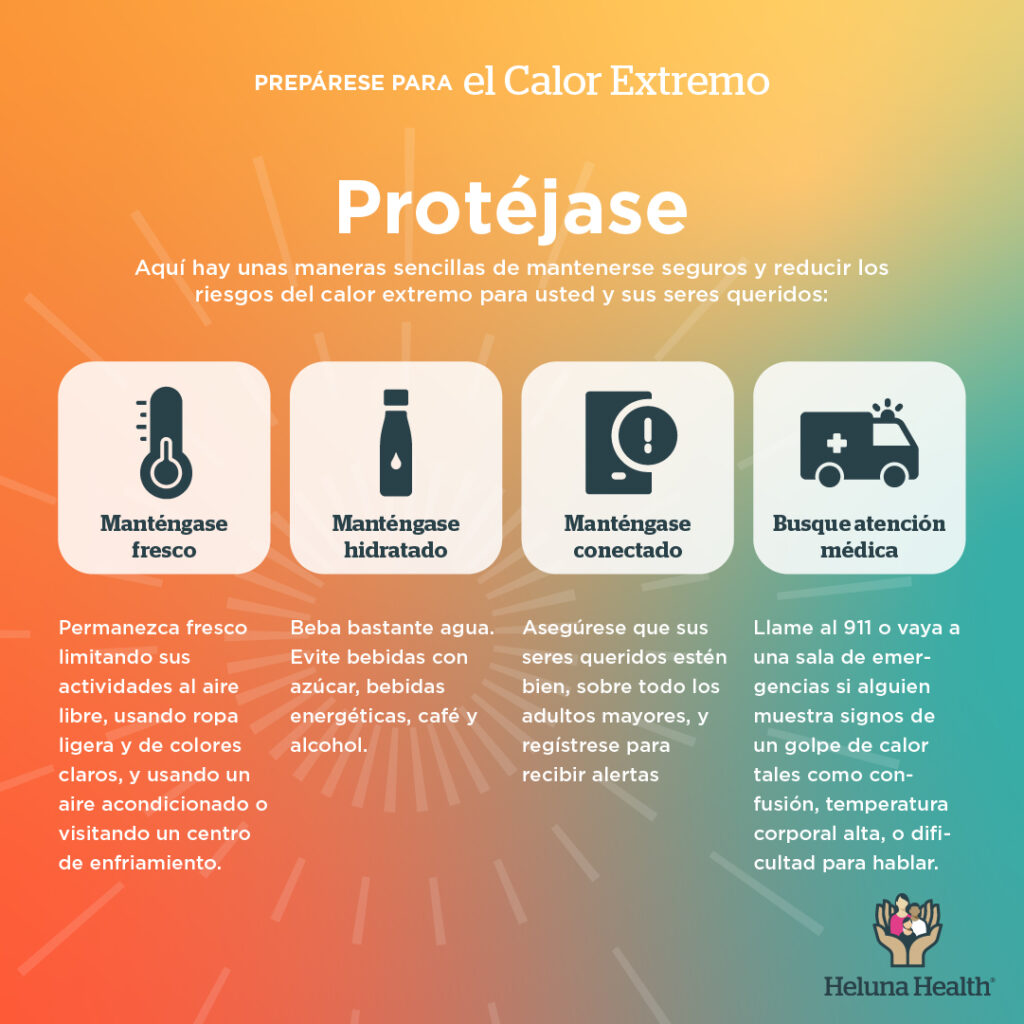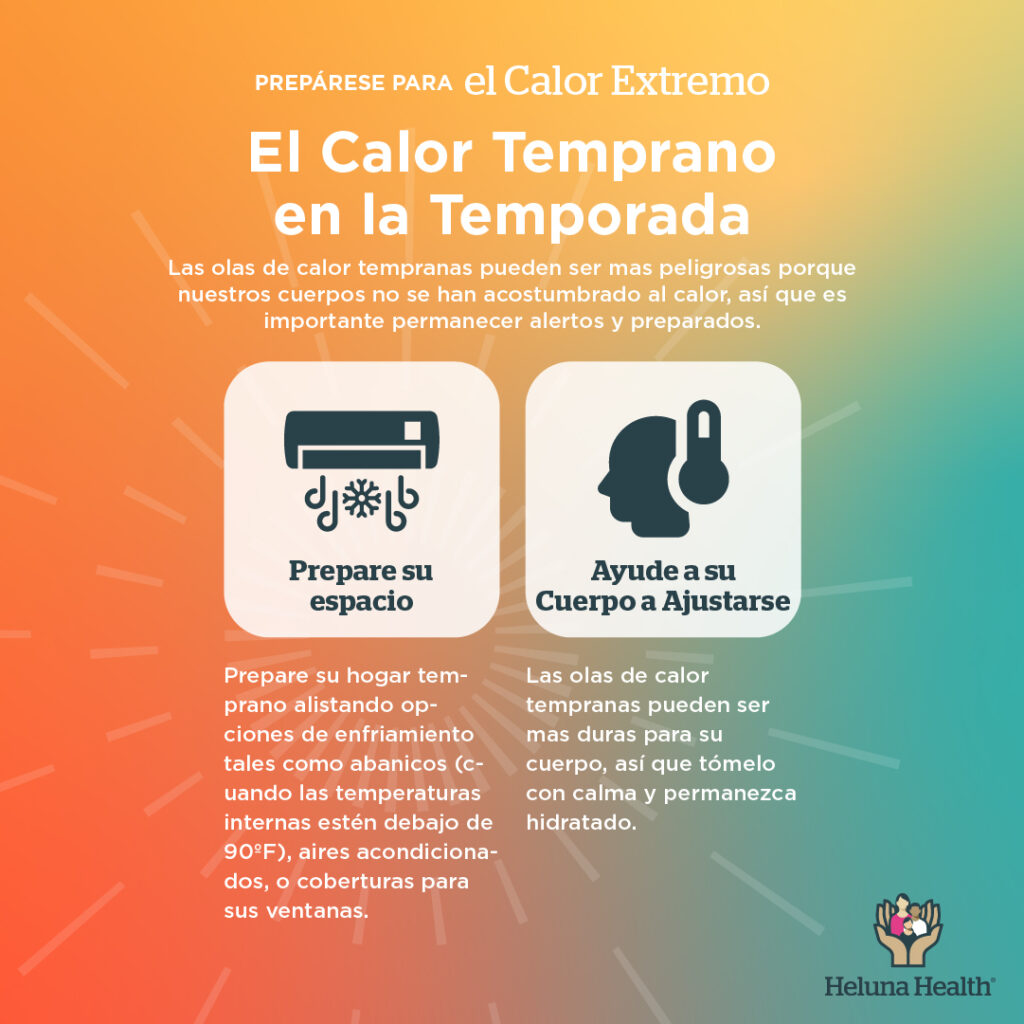- English
- Español
Heat is one of the deadliest natural weather hazards, and the number of yearly heat-related deaths in the United States more than doubled from 1999 to 2023. Extreme heat events (heatwaves) are periods of 2-3 days that are much hotter and/or humid than normal. Climate change is increasing the frequency and intensity of extreme heat events, which are now even occurring in places that aren’t normally hot or humid. By understanding who is at risk, being able to identify the symptoms of heat illness, and knowing what actions to take, you can protect yourself and your loved ones.
As part of the Global Heat Action Day on June 2nd, Heluna Health’s Research and Evaluation team has created an informative resource to help you be prepared for extreme heat:
Early Season Heat is Worst:
Heat occurring early in the season tends to be more harmful because people are less prepared and less acclimatized to heat, meaning that our bodies haven’t yet gotten used to hot temperatures. As more heatwaves occur earlier in the year, we need to stay vigilant, informed, and prepared.
Who’s at Risk:
Everybody can be affected by extreme heat, especially when temperatures are much higher or humid than normal. However, some individuals are always at higher risk, especially children, older adults (ages 65+), pregnant women, and people with certain chronic diseases (heart disease, diabetes, obesity, kidney disease, mental health conditions). Additionally, people who spend a lot of time outdoors (for example, outdoor workers, athletes, and people experiencing homelessness) are also at elevated risk. For more information on who’s most at risk, visit Heat.gov.
Know the Signs of Heat Illness:
Heat can impact our body’s ability to cool itself down. When we experience more heat, we can start to see more serious health problems. Knowing the symptoms of heat illness and when to seek help or take action can save lives.
The Centers for Disease Control and Prevention (CDC) and the National Weather Service provide information about how heat impacts our health, including:
Heat Cramps and overheating are frequently the first sign that the heat is impacting our bodies. Symptoms include painful cramps and spasms, especially in the legs and abdomen, and unusually heavy sweating. Additional symptoms can include nausea, weakness, headaches, and shortness of breath. What to do: Take small sips of water, and seek emergency medical attention if symptoms last longer than 1 hour.
Heat Exhaustion is another way that heat can impact our bodies. Symptoms include heavy sweating, cool, pale, clammy skin, weakness, weak pulse, dizziness, nausea/vomiting, headaches, and fainting. What to do: Go to a cooler place, especially an air-conditioned space, or cool your body (for example, by applying cool compresses or taking a cool bath). Sip water and loosen your clothing. If you vomit, your symptoms get worse, or do not improve after 1 hour, seek emergency medical attention.
Heat Stroke can occur when heat exhaustion is left untreated. This is a dangerous and potentially deadly condition. Symptoms include confusion, slurred speech, body temperatures above 103°F, hot, red, dry or damp skin, rapid and strong pulse, throbbing headaches, nausea, and loss of consciousness. What to do: Call 911 or go to the emergency room immediately. Go to an air conditioned place or cool the victim in any way possible, for example by applying cold compresses or cold baths. If the head index is below 90°F, use a fan (if the heat index is above 90°F, a fan can make you hotter). Unless conscious and alert, DO NOT GIVE FLUIDS.
How to Protect Yourself and Your Loved Ones from Heat:
It’s crucial to protect yourself and your loved ones from the impacts of extreme heat. Here are some simple things you can do to stay safe:
Stay Cool: If you need to be outdoors, limit outdoor activities to the coolest part of the day, and try to stay in the shade as much as possible. Wear cool, lightweight, and light-colored clothing. If you’re indoors, try to cool your indoor spaces by covering windows (for example, with awnings or curtains) and running an air conditioning unit. Only use fans when indoor temperatures are below 90° F. If you cannot use an air conditioning unit, go to a cooling center.
Stay Hydrated: Drink plenty of water. Carry a water bottle and refill it throughout the day. Avoid sodas, coffee, energy drinks, beer, and any drinks that are high in sugar, sodium, caffeine, or alcohol. Stay Connected: Check on your loved ones to make sure that they are safe, especially on older adults who live alone. Register for local weather alerts through the National Weather Service, Ready.gov, or your local emergency alert system.
Seek Care: If you or a loved one are experiencing symptoms of heat illness that don’t improve after 1 hour, seek emergency medical care. If you recognize the signs of a heat stroke, call 911 or seek care at the nearest emergency room.
For more information on how to protect yourself against extreme heat visit the Centers for Disease Control and Prevention website, or visit Ready.gov to explore steps you can take to be prepared.
Cooling Centers are Cool:
It is important to stay safe during extreme heat events by keeping your body cool, and spending time in air conditioned spaces helps cool down your body. If you don’t have or cannot use an air conditioning unit (for example, because of financial concerns or power outages which often happen on very hot days), you can go to a local cooling center.
Cooling centers are public buildings that have air conditioning and are open during the day and sometimes at night. They can be located in a library, community center, senior center, or other space that is set up for public use. Some cooling centers allow individuals to bring their pets (especially those operated by Parks and Recreation departments). If you cannot go to an official cooling center, places like movie theaters, malls, and other air conditioned spaces could also be good options to stay cool if those are more convenient for you.
You can find your nearest cooling center by calling 2-1-1. Your local city or county may also have cooling center information on their webpage.
Additional Information:
If you would like to learn more about the impacts of extreme heat, see our Data Brief: Extreme heat Impacts and Household Preparedness in the Western United States.
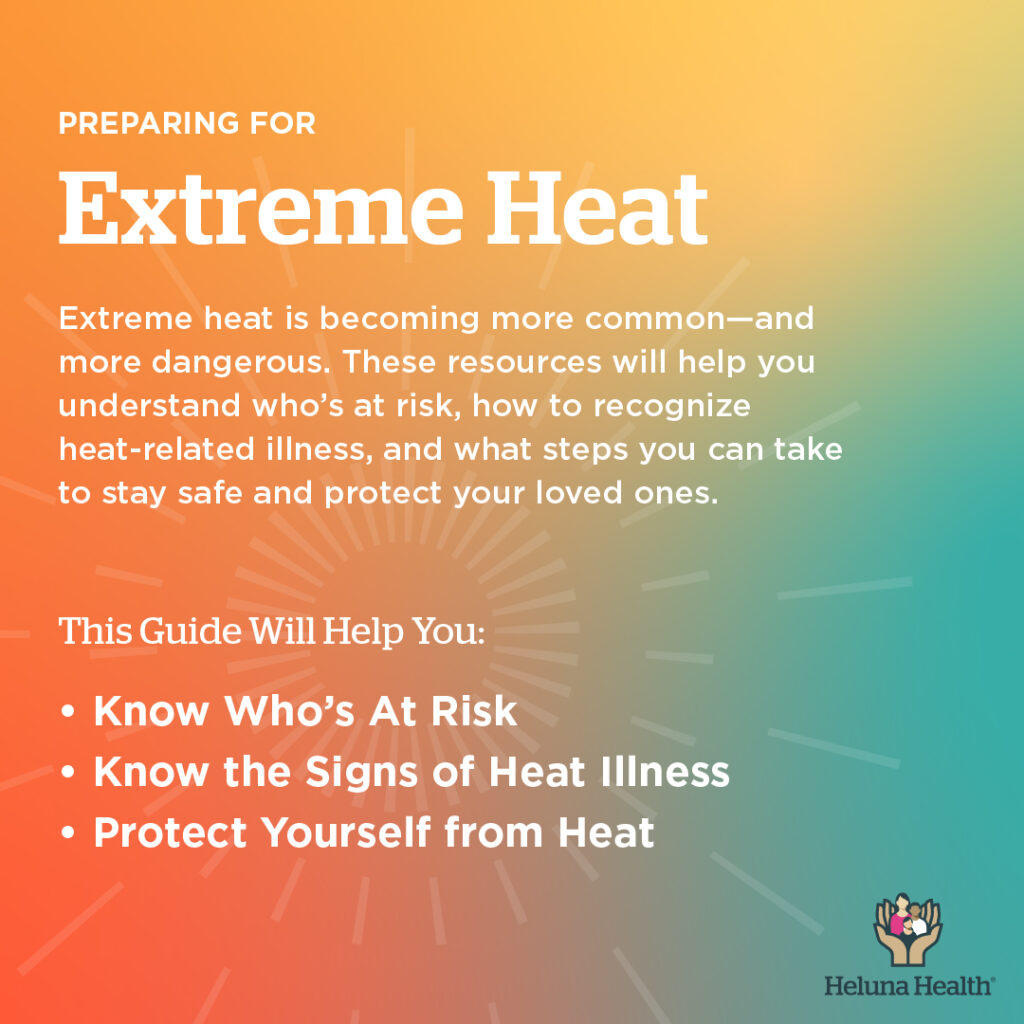
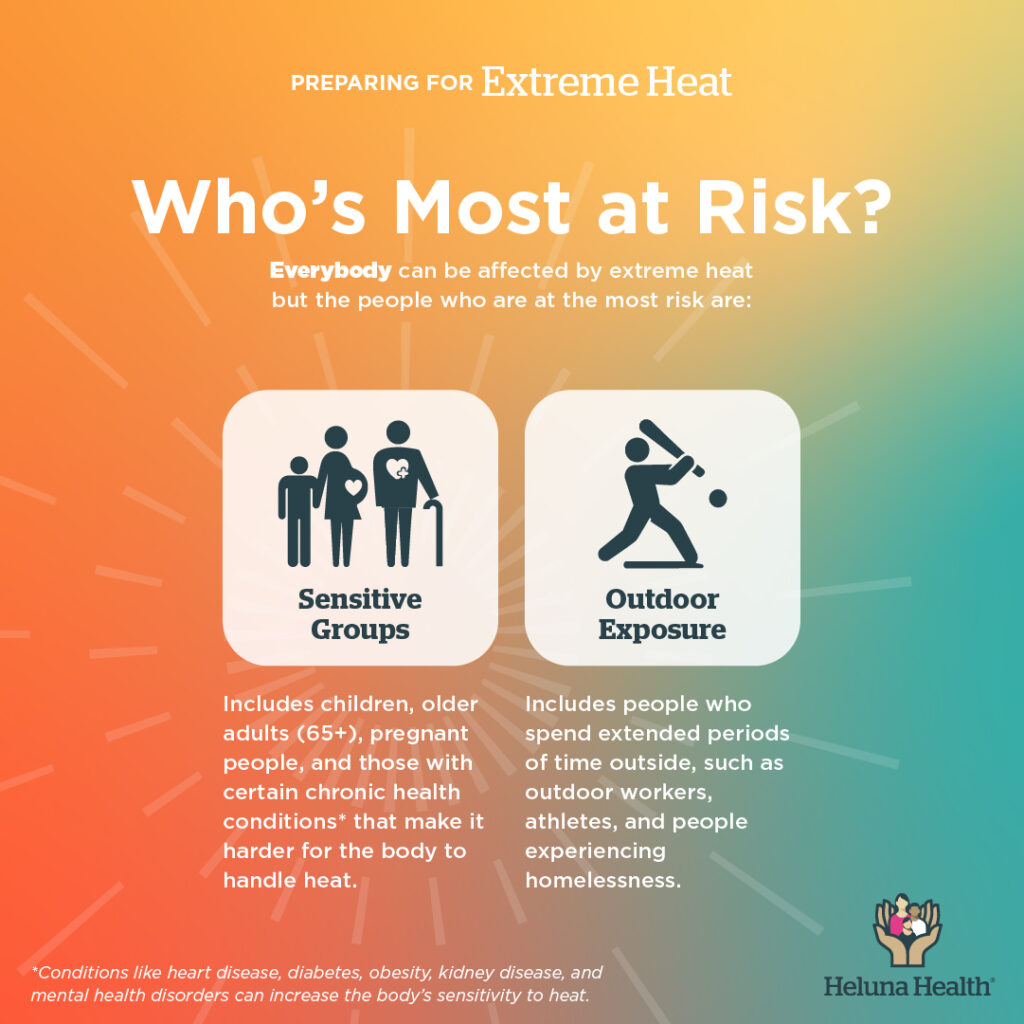
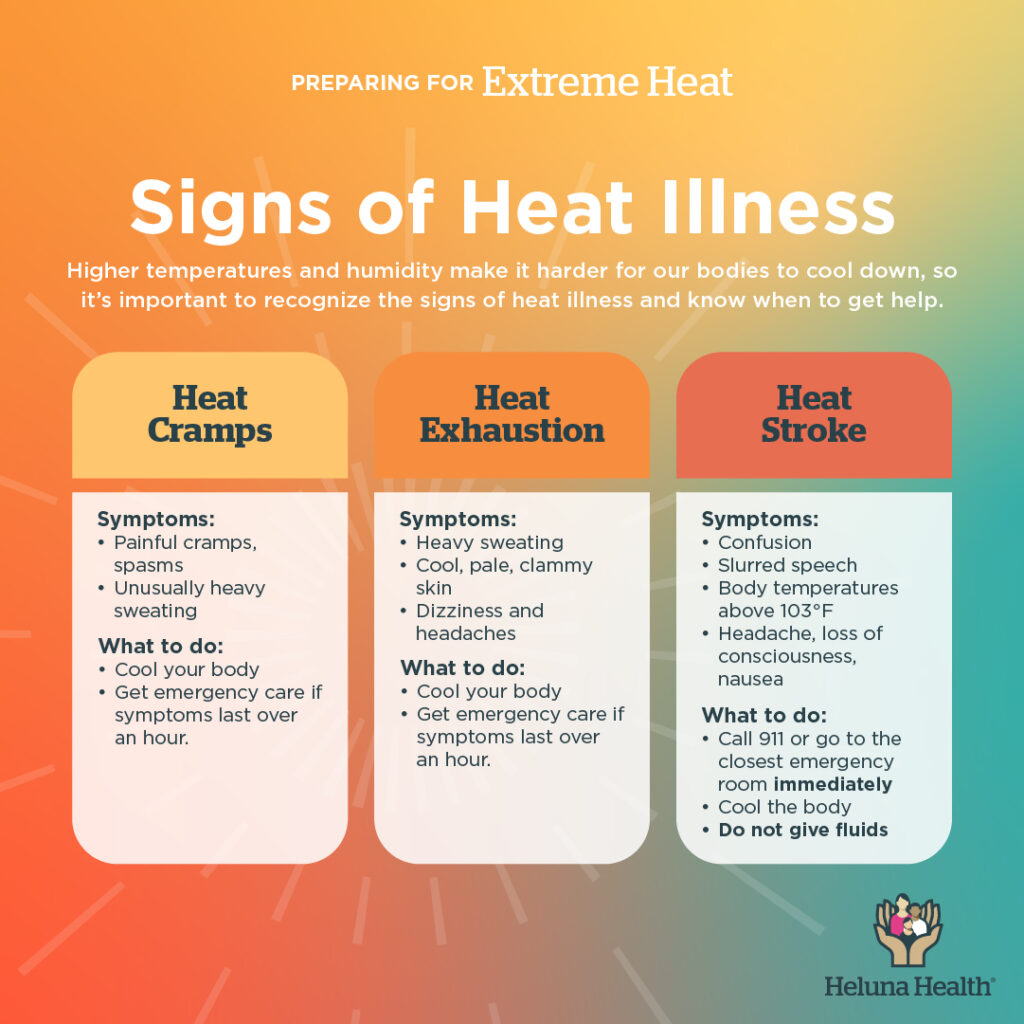
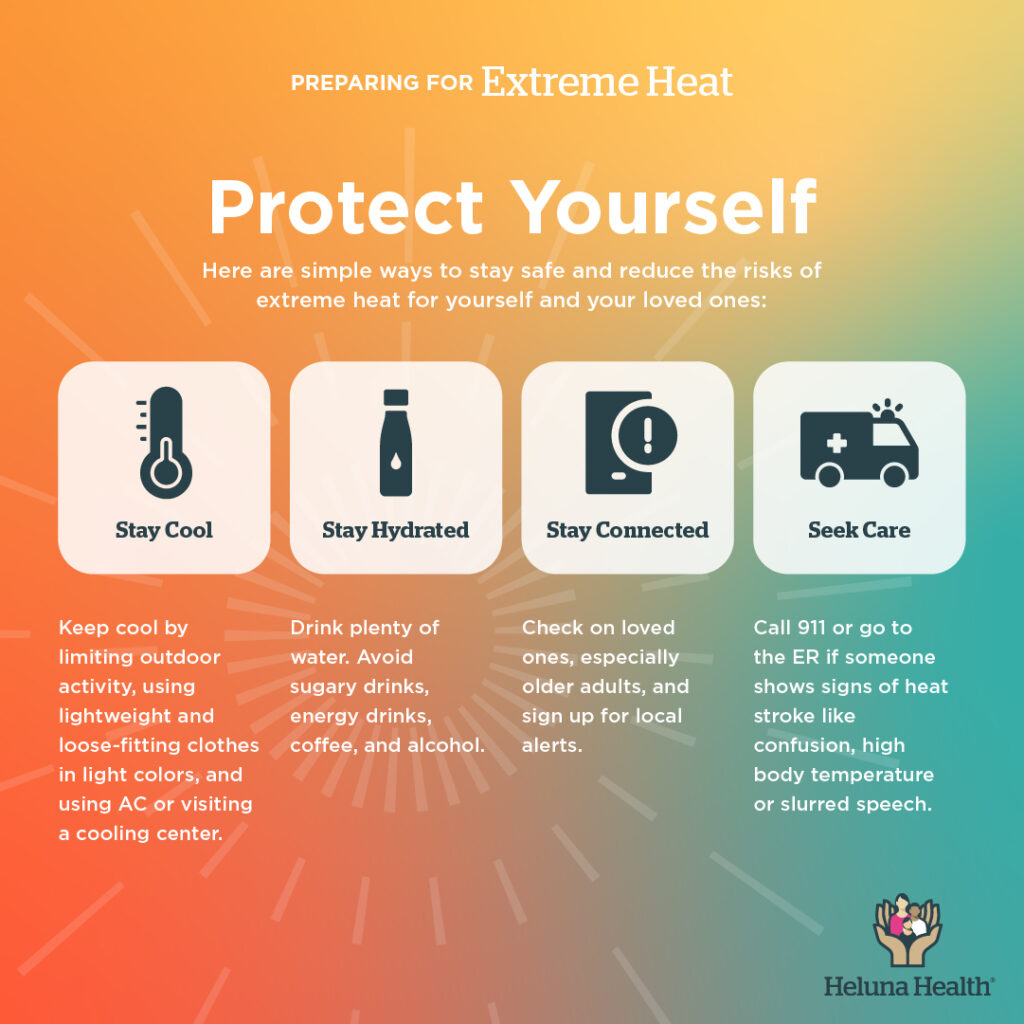
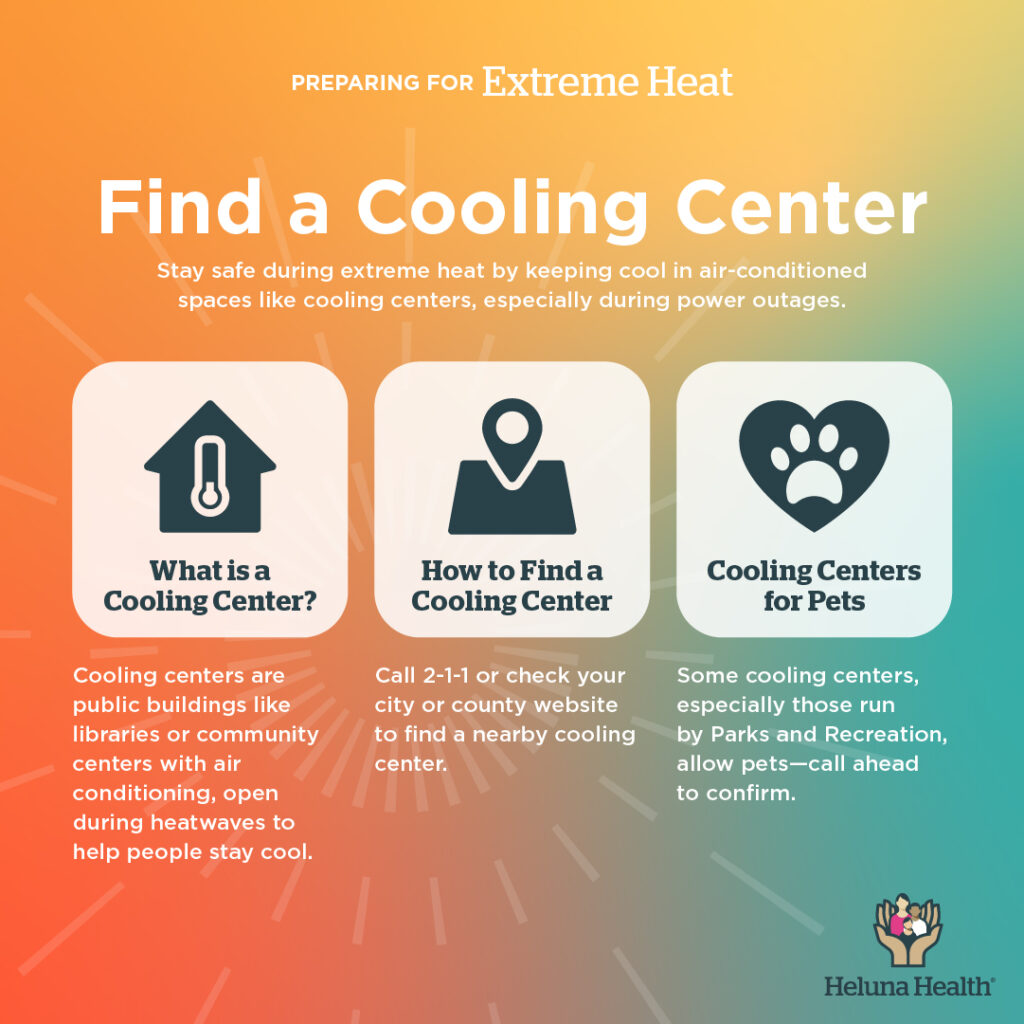
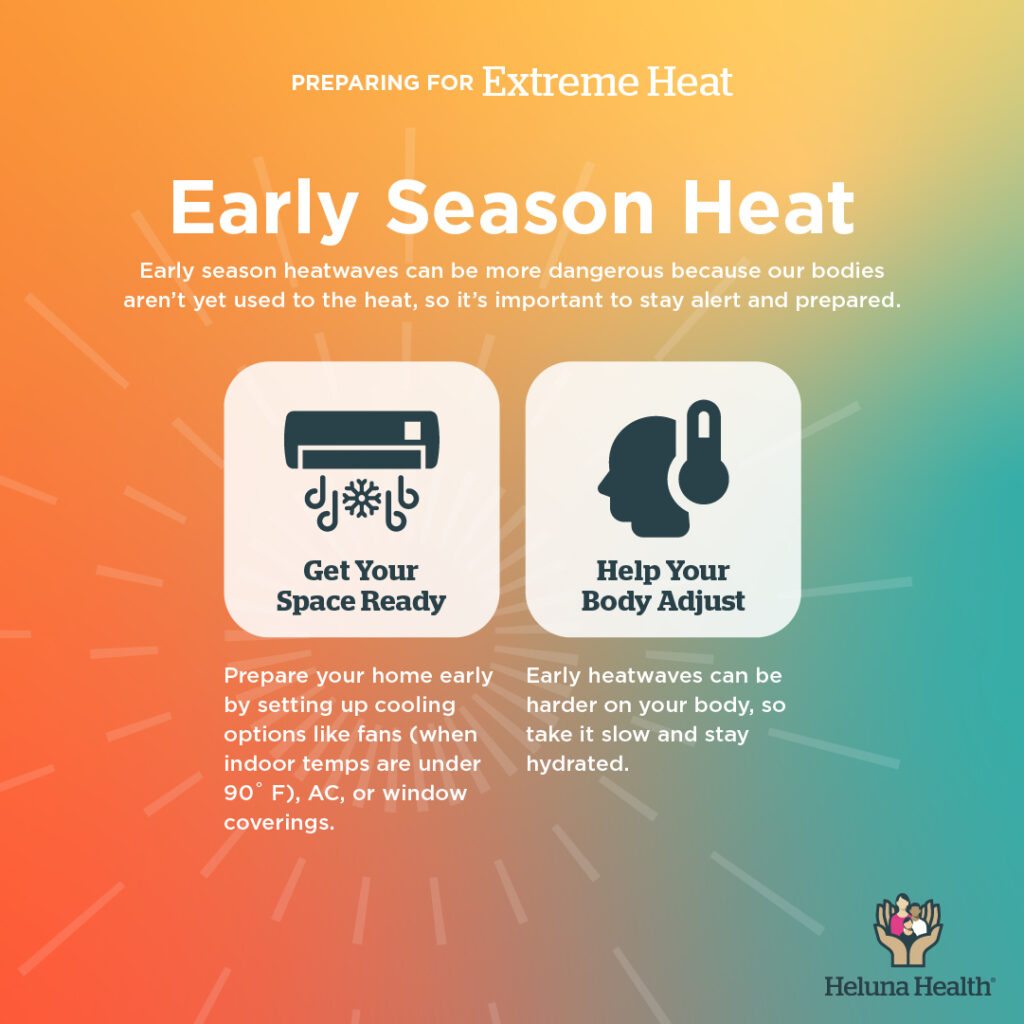
Cómo Prepararse Para el Calor Extremo
El calor extremo es una de las amenazas climáticas más mortales, y el número de muertes anuales relacionadas al calor en los Estados Unidos se ha incrementado más del doble entre 1999 y 2023. Los eventos de calor extremo (olas de calor) son períodos de 2 a 3 días que son mucho más calurosos y/o húmedos de lo normal. El cambio climático está aumentando la frecuencia e intensidad de estos eventos, que ahora incluso ocurren en lugares que no son normalmente cálidos ni húmedos. Al comprender quiénes están en riesgo, aprender a identificar los síntomas de las enfermedades relacionadas con el calor y saber qué acciones tomar, usted puede protegerse a sí mismo y a sus seres queridos de los efectos del calor extremo.
Como parte del Día Mundial de Acción contra el Calor el 2 de junio, el equipo de Investigación y Evaluación de Heluna Health ha creado un recurso informativo para ayudarle a prepararse para el calor extremo:
El calor temprano en la temporada es peor
Los eventos de calor extremo que ocurren al inicio de la temporada tienden a ser más dañinos porque las personas están menos preparadas y menos aclimatadas al calor, que quiere decir que nuestros cuerpos aún no se han acostumbrado a las altas temperaturas. Dado a que las olas de calor están ocurriendo cada vez más temprano en el año, debemos mantenernos vigilantes, informados y preparados.
Quiénes están en riesgo
Todos podemos vernos afectados por el calor extremo, especialmente cuando las temperaturas son mucho más altas o húmedas de lo normal. Sin embargo, algunos grupos siempre tienen un mayor riesgo, especialmente los niños, los adultos mayores (edades mayores a 65), las mujeres embarazadas, las personas con ciertas enfermedades crónicas (enfermedad cardíaca, diabetes, obesidad, enfermedad renal, condiciones de salud mental). Adicionalmente, las personas que pasan mucho tiempo al aire libre (por ejemplo, personas que trabajan al aire libre, atletas y personas sin vivienda) también tienen un riesgo elevado. Para más información sobre quiénes corren mayor riesgo, visite Heat.gov.
Conozca los signos de las enfermedades relacionadas con el calor
El calor puede afectar la capacidad de nuestro cuerpo para enfriarse. Cuando la exposición es prolongada, pueden aparecer problemas de salud más graves. El reconocer los síntomas y saber cuándo actuar o buscar ayuda puede salvar vidas.
Los Centros para el Control y Prevención de Enfermedades (CDC, por sus siglas en inglés) y el Servicio Nacional de Meteorología (NWS, por sus siglas en inglés) brindan información sobre cómo el calor afecta nuestra salud, incluyendo:
Los calambres y el sobrecalentamiento suelen ser la primera señal de que el calor está afectando nuestros cuerpos. Los síntomas incluyen calambres y espasmos dolorosos, especialmente en las piernas y abdomen, y sudoración abundante inusual. Otros síntomas pueden incluir náuseas, debilidad, dolores de cabeza y dificultad para respirar. Qué hacer: Tome pequeños sorbos de agua y busque atención médica de emergencia si los síntomas duran más de 1 hora.
El agotamiento debido al calor es otra manera en que el calor puede afectar nuestros cuerpos. Los síntomas incluyen sudoración abundante, piel fría, pálida y húmeda, debilidad, pulso débil, mareos, náuseas o vómitos, dolores de cabeza y desmayos. Qué hacer: Vaya a un lugar fresco, preferiblemente con aire acondicionado, o enfríe su cuerpo (por ejemplo, con compresas frías o un baño frío). Beba agua y afloje su ropa. Si hay vómitos, empeoran los síntomas o no hay mejoría después de 1 hora, busque atención médica de emergencia.
Un golpe de calor puede ocurrir si el agotamiento debido al calor no se trata. Es una condición peligrosa y potencialmente mortal. Los síntomas incluyen confusión, dificultad para hablar, temperatura corporal superior a 103°F, piel caliente, roja, seca o húmeda, pulso rápido y fuerte, dolores de cabeza intensos, náuseas y pérdida de consciencia. Qué hacer: Llame al 911 o vaya a una sala de emergencias de inmediato. Vaya a un lugar con aire acondicionado o enfríe a la persona afectada de cualquier forma posible (por ejemplo, con compresas frías o baños fríos). Si el índice de calor está por debajo de 90°F, puede usar un ventilador; si es más alto, un ventilador puede empeorar la situación. No dé líquidos a la persona afectada a menos que esté consciente y alerta.
Cómo protegerse y proteger a sus seres queridos del calor
Es crucial que usted se proteja y proteja a sus seres queridos de los efectos del calor extremo. Estas son algunas cosas que puede hacer para mantenerse seguro:
Manténgase fresco: Si necesita estar al aire libre, limite sus actividades a las horas más frescas del día y permanezca en la sombra lo más posible. Use ropa ligera, de colores claros y transpirable. En espacios interiores, mantenga el espacio fresco cubriendo las ventanas (por ejemplo, cerrando cortinas o usando toldos) y encendiendo un aire acondicionado. Use ventiladores solo cuando la temperatura esté por debajo de 90°F. Si no puede usar un aire acondicionado, acuda a un centro de enfriamiento.
Manténgase hidratado: Beba abundante agua. Lleve una botella de agua y rellénela durante el día. Evite refrescos endulzados, café, bebidas energéticas, cerveza y bebidas con alto contenido de azúcar, sodio, cafeína o alcohol.
Manténgase conectado: Asegúrese que sus seres queridos estén bien, especialmente los adultos mayores que viven solos. Regístrese para recibir alertas meteorológicas locales a través del Servicio Nacional De Meteorología, Listo.gov o su sistema local de alertas de emergencia.
Busque atención médica: Si usted o un ser querido tienen síntomas de enfermedades de calor que no mejoran después de 1 hora, busque atención médica de emergencia. Si reconoce los síntomas de un golpe de calor, llame al 911 o acuda a la sala de emergencias más cercana.
Para mayor información sobre cómo protegerse del calor extremo, visite el sitio web de los Centros para el Control y Prevención de Enfermedades o Listo.gov para explorar qué pasos puede tomar.
Los centros de enfriamiento son una buena opción
Es importante permanecer seguros durante los eventos de calor extremo manteniendo nuestros cuerpos frescos, y los espacios con aire acondicionado ayudan a refrescar nuestros cuerpos. Si no tiene aire acondicionado o no puede usarlo (por ejemplo, por razones económicas o cortes de electricidad que ocurren a menudo en días muy calurosos), puede acudir a un centro de enfriamiento local.
Los centros de enfriamiento son edificios públicos con aire acondicionado que están abiertos al público durante el día y, en algunos casos, durante la noche. Pueden estar ubicados en bibliotecas, centros comunitarios, centros para personas mayores u otros espacios públicos. Algunos permiten llevar mascotas (especialmente los administrados por el Departamento de Parques y Recreación). Si no puede ir a un centro de enfriamiento oficial, lugares como cines, centros comerciales u otros espacios con aire acondicionado también pueden ser buenas opciones si son más convenientes para usted.
Puede encontrar el centro de enfriamiento más cercano a usted llamando al 2-1-1. Su ciudad o condado también puede tener información sobre estos centros en su página web.
Información adicional: Si desea obtener más información sobre los impactos del calor extremo, consulte nuestro Resumen de datos: Impactos del calor extremo y preparación de los hogares en el oeste de Estados Unidos.
